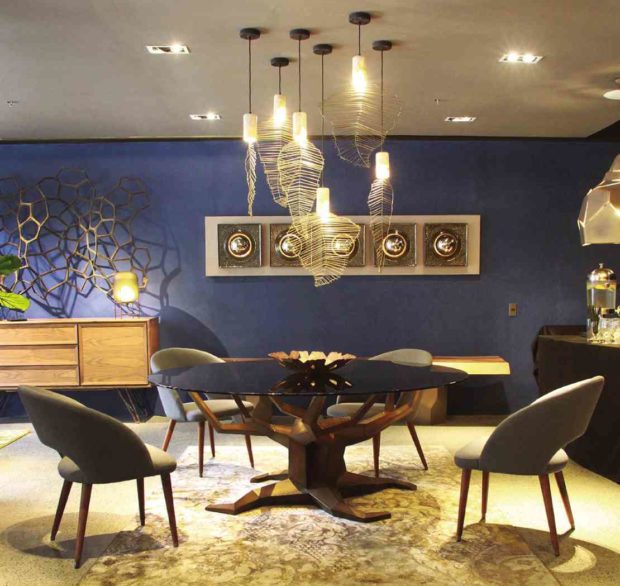
A decade ago, designer-entrepreneurs Jude Tiotuico and Eric Paras were making furniture for a major American company. One day, they hit the jackpot.
Their creation, the Turner, was a backless barstool made of steel sheet and tubular metal, with a round seat fastened by a rivet that enabled it to swivel. Its combination of crisp lines, soft curves and the aged patina of metal rode the trend in vintage industrial look.
Imitators copied its landmark design.
Although the Turner stool marked a turning point for the Filipino designers, they created it for an American brand, not theirs, so they didn’t get the credit.
Tiotuico went on to do his own collection, Industria Edition. The design DNA is a fusion of Tiotuico’s expertise in metal finishes and unusual forms, and Paras’ transitional style, a combination of traditional and modern elements.
Paras explains that the use of metal and its various surface treatments are the strengths of the company’s manufacturing arm. While others capitalize on polished metal, Industria Edition experiments with other finishes such as verdigris, a green pigment, and other patina of a natural, timeworn look. And the surfaces are protected to last, says Paras.
In 2019, metals will be in demand, interpreted in gold, brass or blackened finish and will be used in lacy, mesh or massive designs.
Collaborations
The Industria Edition showroom at the Residences at Greenbelt shows the range of Tiotuico’s designs.
A divider, Reef, suggests the waves on the reefs.
Winner of the Katha Award, the Loopy Chair was inspired by hammocks. The seat is made of handwoven leather, supported by loops of forged black iron and copper pipes.
The bestseller among Industria’s designs is the Cubico, a black iron cube table.
Starburst lights are groups of steel balls with lacelike patterns resembling pointed stars.
The six-seat sofa, Tayo-Tayo, is characterized by an undulating back.
Tiotuico’s artwork, “Puzzle,” consists of black iron pieces, cut into different shapes and fitted within the frame.
The showroom also presents other designers whom Tiotuico has worked with.
Design deacon Budji Layug’s dining table is a collaboration with Tiotuico. It looks like a tree with branches spreading out to hold up the solid wood and glass top. The base, resembling the trunk, is made of steel sheets with bronze finish that gives it a natural look.
Designer Lilianna Manahan’s handwoven leather chair, with curved copper frame and armrest, is a forward-looking version of an umpire chair. She draws reference from history—Austrian-German furniture maker Michael Thonet’s light but sturdy bentwood chair that was developed in the 19th century and which required few furniture parts.
Artist Leeroy New created a coffee table of bent steel and cut glass.
Cemetery canopies
Paras’ steel chair with velvet upholstery was inspired by the Art Deco period when light-reflecting polished surfaces were combined with luxurious textures.
Tiotuico’s foray into furniture was born out of passion.
In the early ’90s, Tiotuico, then a banker, and his friend Arthur Viray, an airline ground steward, grew tired of their desk jobs.
Since Tiotuico knew of a welder, he and Viray (now Industria’s president) ventured into producing objects made of metal frames, grills, gates and cemetery canopies.
Eventually, their manufacturing company, then called Vico (abbreviation of Viray and Tiotuico) Inc., became a subcontractor of furniture exporters.
They joined trade shows and bagged a big-time client, a French firm. Tiotuico supplied designs based on the client’s specifications.
One day, their client sold the company, so Tiotuico had to find a new strategy to stay in business.
A fellow Kapampangan and furniture designer, Randy Viray, showed him the works of Paras.
Tiotuico was impressed with Paras’ transitional style, characterized by sophisticated silhouettes using straight lines and softly rounded silhouettes. Paras’ enduring designs could complement many furniture settings without looking dated.
In 2007, Tiotuico and Paras established Industria. They chose the name to pay homage to metal and the vintage industrial look.
Paras tamed Tiotuico’s capricious designs into attractive, functional and salable pieces. Being an interior designer, Paras taught him how to create styles that would easily blend with any décor.
With a new collection reflecting their vision, they joined the Manila FAME.
Their use of metal distinguished them.
“No homeowner would furnish their home with all-steel furniture,” says Tiotuico. “They would buy wooden furniture from Designs Ligna or contemporary pieces from Furnitalia. How do you bridge the gap? We’d like interior designers to think of Industria when they need some pieces.”
In 2013, Layug, then a consultant to the Center for International Trade Expositions and Missions (Citem), was impressed with Industria’s unique treatment of metal. Layug and Kenneth Cobonpue, another design authority, selected Industria to be part of Design Philippines, Citem’s program for promoting the best local manufacturers abroad.
Layug encouraged Tiotuico to be more bullish about the branding of Industria and to think like a designer who balances art and commerce.
The company has been rebranded as Industria Edition. —CONTRIBUTED